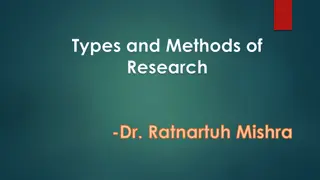Value of Ethnographic Re-Studies: Exploring Tensions and Contradictions in Social Research
Ethnographic re-studies play a crucial role in examining changes over time and exploring new dimensions of a case. However, tensions arise due to challenges in replicating the original study, changes in the community, and variations in findings based on researchers' perspectives. Classic controversies in anthropology, such as the contrast between Redfield and Lewis's accounts of Tepoztlán, highlight the complexities of interpreting social phenomena over time.
Download Presentation

Please find below an Image/Link to download the presentation.
The content on the website is provided AS IS for your information and personal use only. It may not be sold, licensed, or shared on other websites without obtaining consent from the author.If you encounter any issues during the download, it is possible that the publisher has removed the file from their server.
You are allowed to download the files provided on this website for personal or commercial use, subject to the condition that they are used lawfully. All files are the property of their respective owners.
The content on the website is provided AS IS for your information and personal use only. It may not be sold, licensed, or shared on other websites without obtaining consent from the author.
E N D
Presentation Transcript
Reflections on the value of ethnographic re-studies Martyn Hammersley The Open University Symposium to celebrate the academic career of Professor Robert Burgess, University of Leicester, May 2014
Background Study and Re-study of Bishop McGregor: 1973-4, 1984 (Burgess 1981, 1983, 1987). The rarity of re-studies in the sociology of education. Re-studies much more common in the field of anthropological and sociological community studies (Crow 2012). Investigation of schools-as-communities: Hargreaves (1967), Lacey (1970), Ball (1980), Burgess (1983). Problems with re-studies: getting back into the field, controversies over findings.
Rationales for re-studies Replication Mapping change over time Exploring new aspects of a case Many re-studies combine these three purposes. There are some tensions amongst them.
Tensions If the original study was not sound, it cannot be used as a baseline to investigate change. If the community has changed, then replication is no longer possible. If the re-study investigates different aspects of the institution or community from the original investigation, it can serve neither replication nor the mapping of change. Is not variation in findings simply a product of differences in the personal outlook of the researcher or of the methods and theoretical framework used?
A couple of classic controversies Robert Redfield (1930) and Oscar Lewis (1951) on Tepoztl n: where Redfield found harmony, Lewis found conflict . Margaret Mead (1928), Wendell Holmes (1987), and Derek Freeman (1983, 1998) on Samoa: the greatest controversy in anthropology for over 100 years (see Bryman 1994).
The contrast between the accounts of Redfield and Lewis Lewis found Tepoztl n to be strikingly different from the way that Redfield had portrayed it. Whereas Redfield had seen Tepoztl n as a harmonious and contented village, Lewis discovered it to be riven with strife. Not only were villagers discontented because they were ill-fed and disease-ridden, but also they were filled with jealousy for and mistrust of their fellow villagers. Tepoztl n, in short, did not resemble the intimate folk society Redfield had described. (Wilcox 2004:66)
Explaining the discrepancy Redfield or Lewis got it wrong, or perhaps both did. Tepoztl n had changed in the interim. The discrepancies between the two accounts reflect differences in the personalities, theoretical orientations, or methodological approaches of the two investigators.
This case provides a most interesting example of the difference in perception and selection of materials between the two ethnographers. Redfield was interested in harmony; he was interested in what made things go well. Oscar, as everybody knows, was interested in what made things go badly. As a result, those two studies which are very interesting and very informative, are excellent statements about the temperaments of those two men. (Mead 1976:144) Replying to criticism, Lewis writes: It seems to me that concern with what people suffer from is more productive of insight about the human condition, about the dynamics of conflict and the forces for change. To stress the enjoyment in peasant life [as Redfield agreed he did] is to argue for its preservation and inadvertently to boost tourism (Lewis 1970:252).
Variation in the character of re-studies Lone researcher versus team research. Original researcher(s) carry out the re-study versus new researcher(s) carrying it out. Same methods versus different methods employed. Short versus long time period between study and re-study. These types of variation have important implications for the nature of any re-study, and for which of the purposes it can serve.
Burgess re-study Single researcher on both occasions. Same researcher carried out original study and re- study. Somewhat different methods employed. 10 year time gap. Slightly different focus: original study examined the experience of teachers and students in Newsom classes , whereas re-study looked particularly at the role of the headteacher and the senior management team. Useful findings, for example about the effects of falling rolls on schools. And little controversy!
Questions Do re-studies simply open up a logical impasse, revealing or perhaps even generating intractable problems, thereby damaging the reputation of social research? Or do they, as Redfield argued, demonstrate the power of social science to revise its conclusions and to move towards the truth , a point with which Lewis agreed? It is easy to exaggerate the discrepancies between studies, and this has been done in some of the controversies, and to exaggerate the tensions among different purposes of re-study. Usually they can be resolved pragmatically, as Bob showed.
Conclusion: the value of re-study It highlights threats to the validity of social research findings, but can also show that the findings are more robust than critics claim. Provides a means of assessing the significance of validity threats. Offers a strategy for investigating change in ways that take account of local variation, for example as regards the impact of state policies, or of broad social trends. Why aren t more re-studies done? The idolatry of the new!
References Ball, S. (1981) Beachside Comprehensive: A case-study of comprehensive schooling, Cambridge, Cambridge University Press. Bryman, A. (1994) 'The Mead/Freeman Controversy: Some Implications for Qualitative Researchers', in R. G. Burgess (ed.) Studies in Qualitative Methodology, Vol. 4, Greenwich CT, JAI Press. Burgess, R. G. (1981) An Ethnographic Study of a Comprehensive school, unpublished PhD thesis, University of Warwick. Burgess, R. G. (1983) Experiencing Comprehensive Education: a study of Bishop McGregor School, London, Methuen. Burgess, R. (1987) Studying and re-studying Bishop McGregor school , in Walford, G. (ed.) Doing Sociology of Education, London, Falmer Press. Freeman, D. (1983) Margaret Mead and Samoa: the making and unmaking of an anthropological myth, Cambridge MA, Harvard University Press. Freeman, D. (1998) The Fateful Hoaxing of Margaret Mead: A historical analysis of her Samoan research, Boulder, Westview Press. Hargreaves, D. H. (1967) Social Relations in a Secondary School, London, Routledge and Kegan Paul. Holmes, L. (1987) Quest for the Real Samoa: the Mead-Freeman controversy and beyond, Massachusetts, Bergin and Harvey. Lacey, C. (1970) Hightown Grammar, Manchester, Manchester University Press. Lewis, O. (1951) Life in a Mexican Village: Tepoztl n Restudied, Urbana, ILL, University of Illinois Press. Lewis, O. (1953) Controls and experiments in fieldwork , in Kroeber, A. (eds) Anthropology Today, Chicago, University of Chicago Press. Lewis, O. (1970) Anthropological Essays, New York, Random House. Mead, M. (1928) Coming of Age in Samoa, New York, Morrow. Mead, M. (1976) Discussion: American ethnology: the role of Redfield (other discussants: J. Collins, E. C. Hughes, and J. Griffin), in Murra, J. (ed.) American Anthropology: the early years, Proceedings of the American Ethnological Society 1974, St Paul MINN, West Publishing Co. Redfield, R. (1930) Tepoztl n: A Mexican Village, Chicago, University of Chicago Press.























